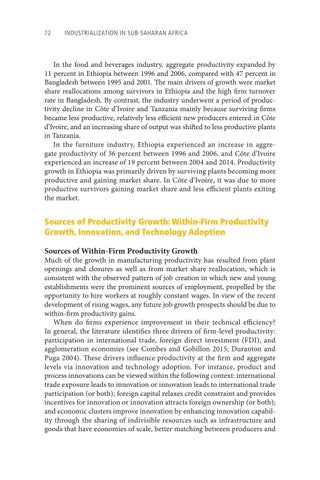72 Industrialization in Sub-Saharan Africa
In the food and beverages industry, aggregate productivity expanded by 11 percent in Ethiopia between 1996 and 2006, compared with 47 percent in Bangladesh between 1995 and 2001. The main drivers of growth were market share reallocations among survivors in Ethiopia and the high firm turnover rate in Bangladesh. By contrast, the industry underwent a period of productivity decline in Côte d’Ivoire and Tanzania mainly because surviving firms became less productive, relatively less efficient new producers entered in Côte d’Ivoire, and an increasing share of output was shifted to less productive plants in Tanzania. In the furniture industry, Ethiopia experienced an increase in aggregate productivity of 36 percent between 1996 and 2006, and Côte d’Ivoire experienced an increase of 19 percent between 2004 and 2014. Productivity growth in Ethiopia was primarily driven by surviving plants becoming more productive and gaining market share. In Côte d’Ivoire, it was due to more productive survivors gaining market share and less efficient plants exiting the market.
Sources of Productivity Growth: Within-Firm Productivity Growth, Innovation, and Technology Adoption Sources of Within-Firm Productivity Growth
Much of the growth in manufacturing productivity has resulted from plant openings and closures as well as from market share reallocation, which is consistent with the observed pattern of job creation in which new and young establishments were the prominent sources of employment, propelled by the opportunity to hire workers at roughly constant wages. In view of the recent development of rising wages, any future job growth prospects should be due to within-firm productivity gains. When do firms experience improvement in their technical efficiency? In general, the literature identifies three drivers of firm-level productivity: participation in international trade, foreign direct investment (FDI), and agglomeration economies (see Combes and Gobillon 2015; Duranton and Puga 2004). These drivers influence productivity at the firm and aggregate levels via innovation and technology adoption. For instance, product and process innovations can be viewed within the following context: international trade exposure leads to innovation or innovation leads to international trade participation (or both); foreign capital relaxes credit constraint and provides incentives for innovation or innovation attracts foreign ownership (or both); and economic clusters improve innovation by enhancing innovation capability through the sharing of indivisible resources such as infrastructure and goods that have economies of scale, better matching between producers and

